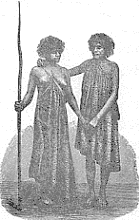From
the beginnings of anthropology in the mid 19th century, researchers have tried
to classify the cultures of the world in a meaningful way. They have
sought to develop categories of cultures that would help explain a wide range
of behavior patterns. However, initial attempts at doing this were not
very useful.
 |
 |
|
| 19th century
European stereotype of "primitives" (left: Koreans; right: Australian Aborigines) |
||
During the 19th and early 20th centuries, the educated public in Europe and North America generally divided the world's people into two categories--primitive and civilized. This fell far short of describing the full range of differences between cultures. It was also prejudicial and very misleading. It generally emphasized technological and social characteristics. For instance, a society was considered primitive if its people did not wear much clothing, did not have elaborate machinery, and practiced polygamy. In other words, if people were very different from Europeans, they were considered primitive. This ignored the fact that some of the so-called primitive peoples had complex social systems and religions.
Late
19th century anthropologists, such as Edward B. Tylor in England and Lewis Henry
Morgan in the United States, developed classification schemes that were only
slight refinements over the primitive-civilized distinction made by
non-anthropologists. Their systems included three main categories of
cultures--savages, barbarians, and civilized peoples. While each of
these categories was sub-divided into smaller ones in order to be more
precise, this was still a naive, simplistic, and quite ethnocentric
![]() approach
due to the fact that it was largely based on a comparison with European
cultures.
approach
due to the fact that it was largely based on a comparison with European
cultures.
By
the 1930's, enough first hand ethnographic
![]() data about
the cultures of the world had been gathered for anthropologists to understand
that there is a better way of categorizing them. They based their
distinctions primarily on differences in subsistence patterns--i.e.,
sources and methods a society uses to obtain its food and other
necessities. This focus on economic differences proved to be
useful because much of the rest of a culture is directly related to its
economy. If you know what the subsistence base is, it is possible to
predict many of the other basic cultural patterns. There is a
surprisingly high positive correlation between the type
of economy and such things as population sizes and densities, social and political
systems, scale of warfare, and complexity of science, mathematics, and
technology. Using this approach, anthropologists divided the cultures of
the world into four basic subsistence types:
data about
the cultures of the world had been gathered for anthropologists to understand
that there is a better way of categorizing them. They based their
distinctions primarily on differences in subsistence patterns--i.e.,
sources and methods a society uses to obtain its food and other
necessities. This focus on economic differences proved to be
useful because much of the rest of a culture is directly related to its
economy. If you know what the subsistence base is, it is possible to
predict many of the other basic cultural patterns. There is a
surprisingly high positive correlation between the type
of economy and such things as population sizes and densities, social and political
systems, scale of warfare, and complexity of science, mathematics, and
technology. Using this approach, anthropologists divided the cultures of
the world into four basic subsistence types:
This classification system is still used in anthropology today due to its usefulness for understanding human cultural diversity. However, the last category, intensive agriculture, is sometimes nuanced by expanding it to include 20th and 21st century industrial and post-industrial economic systems.